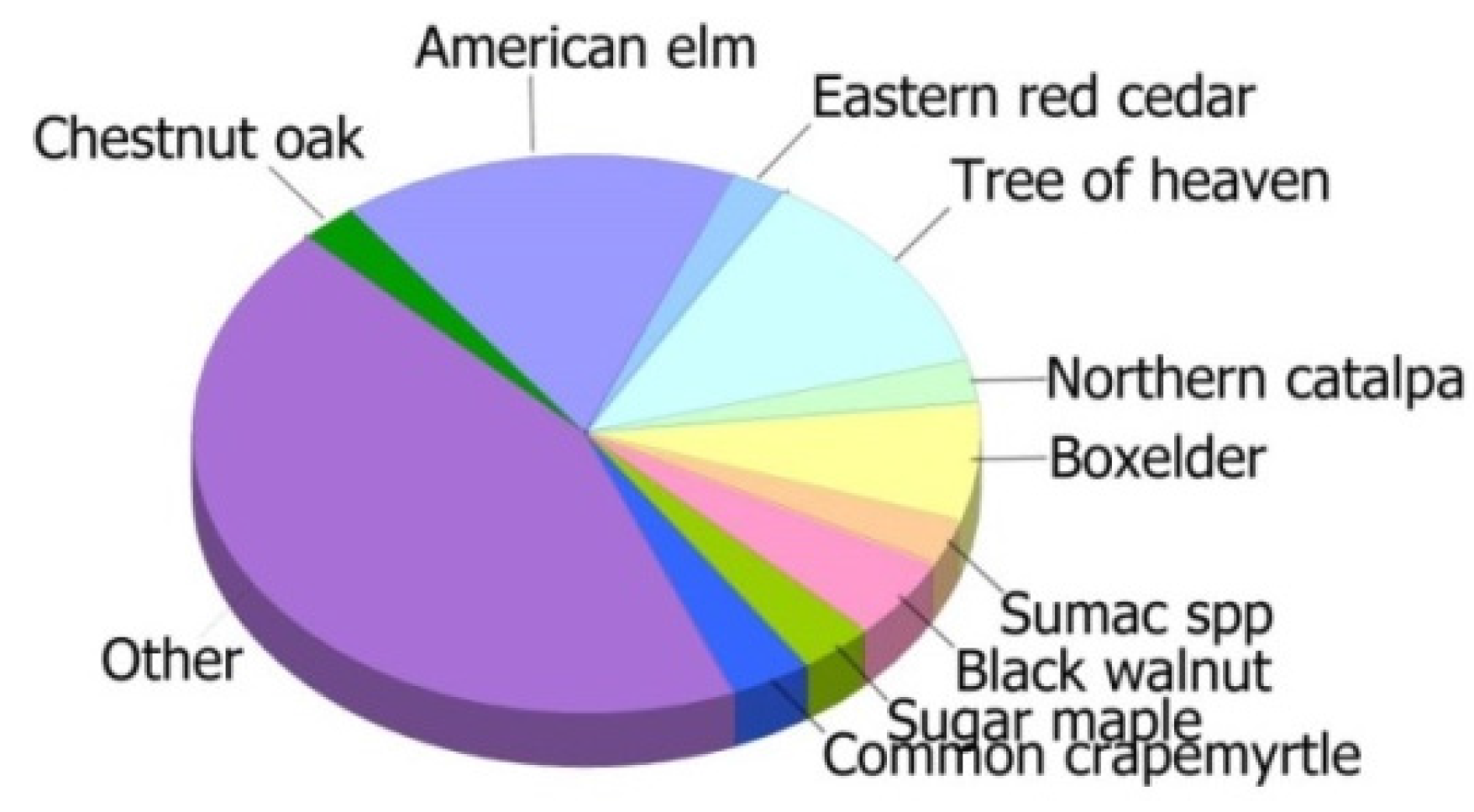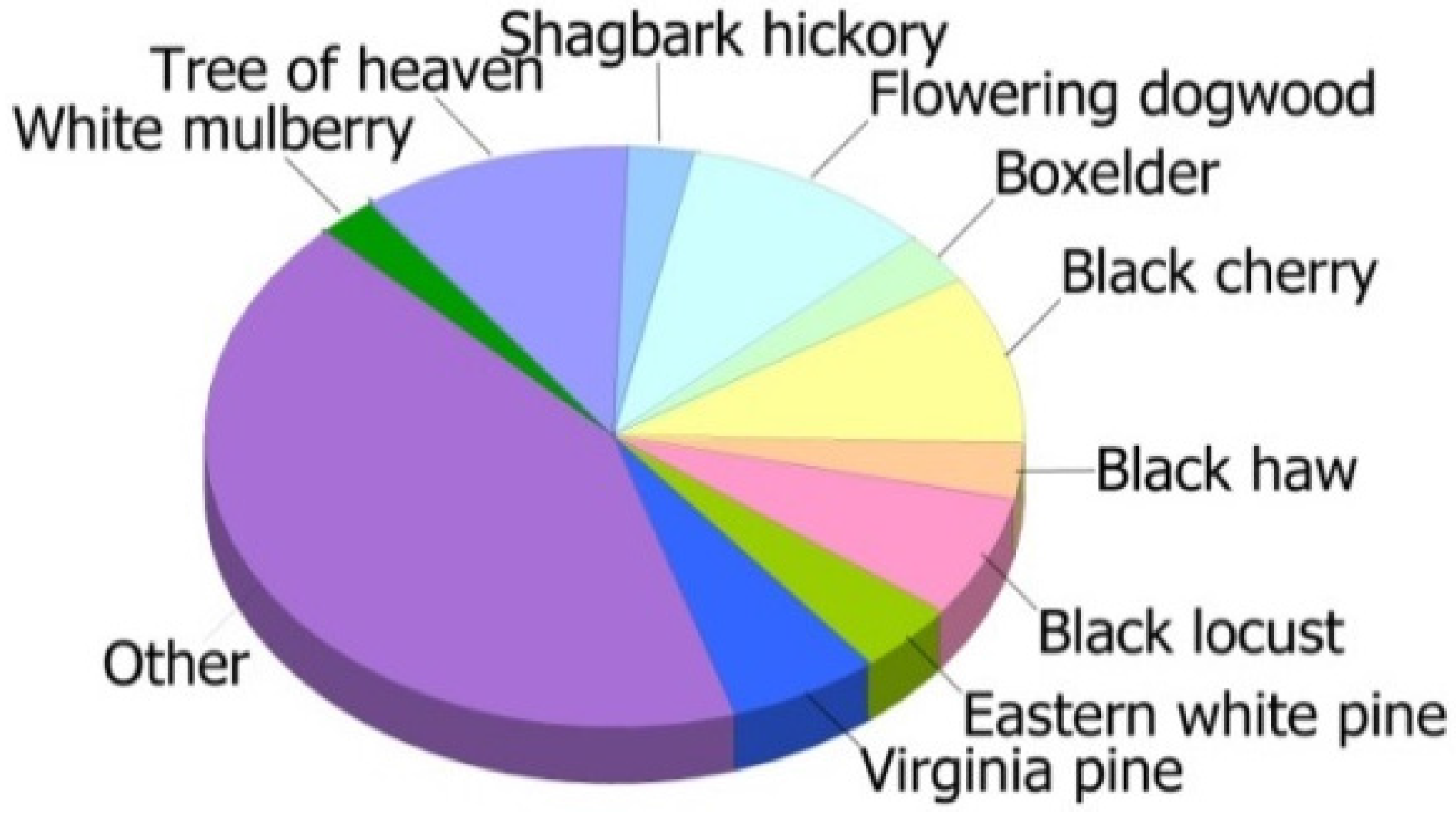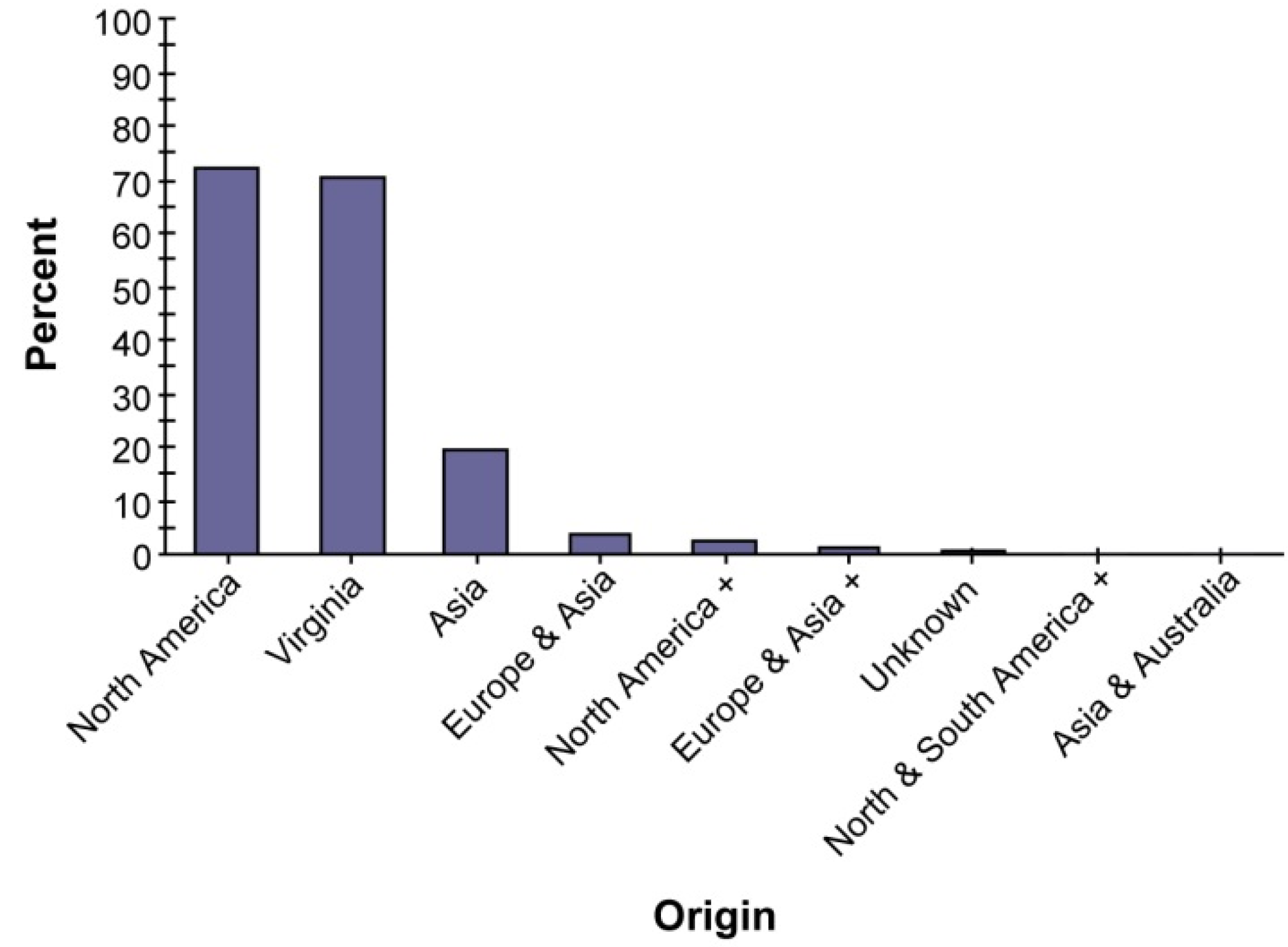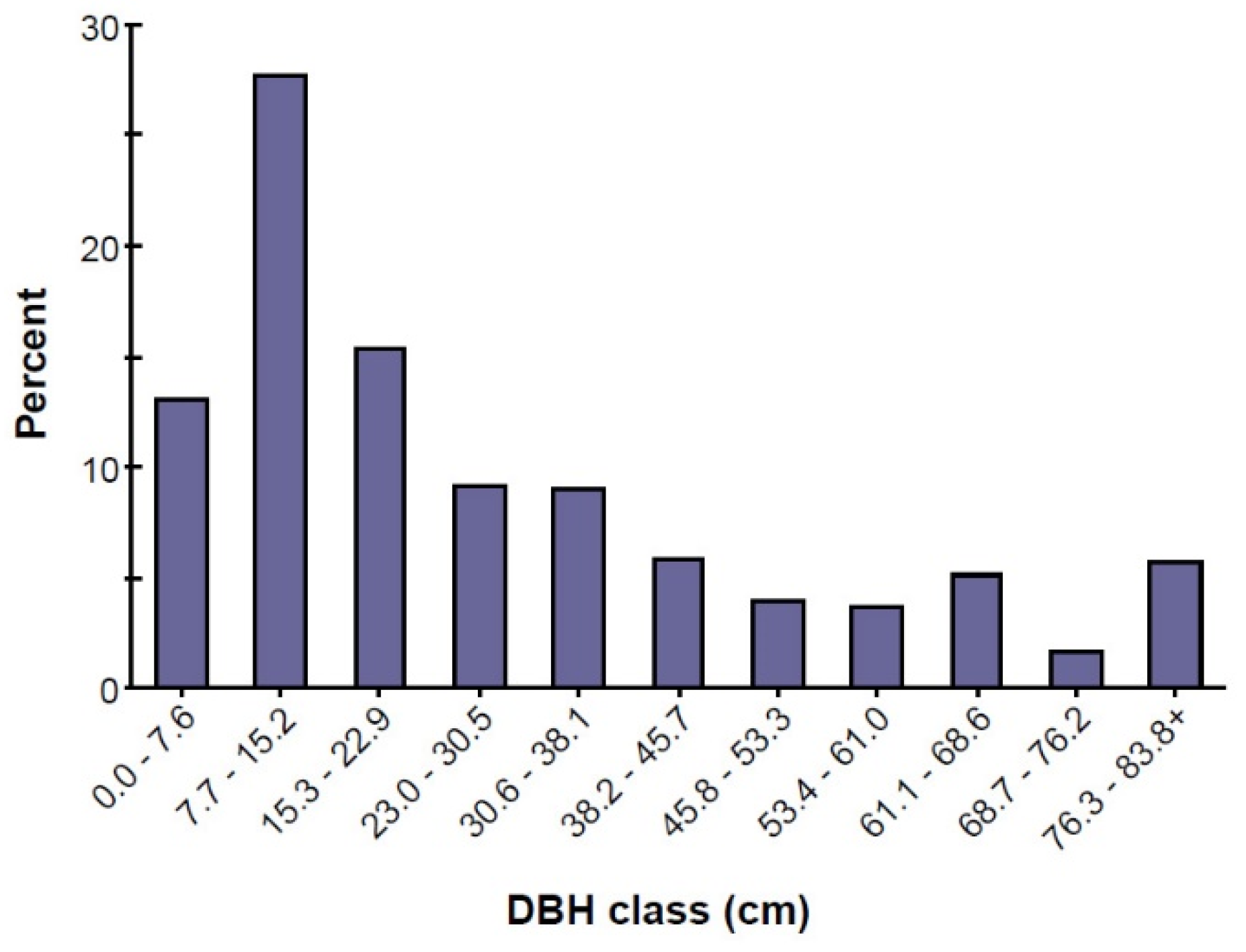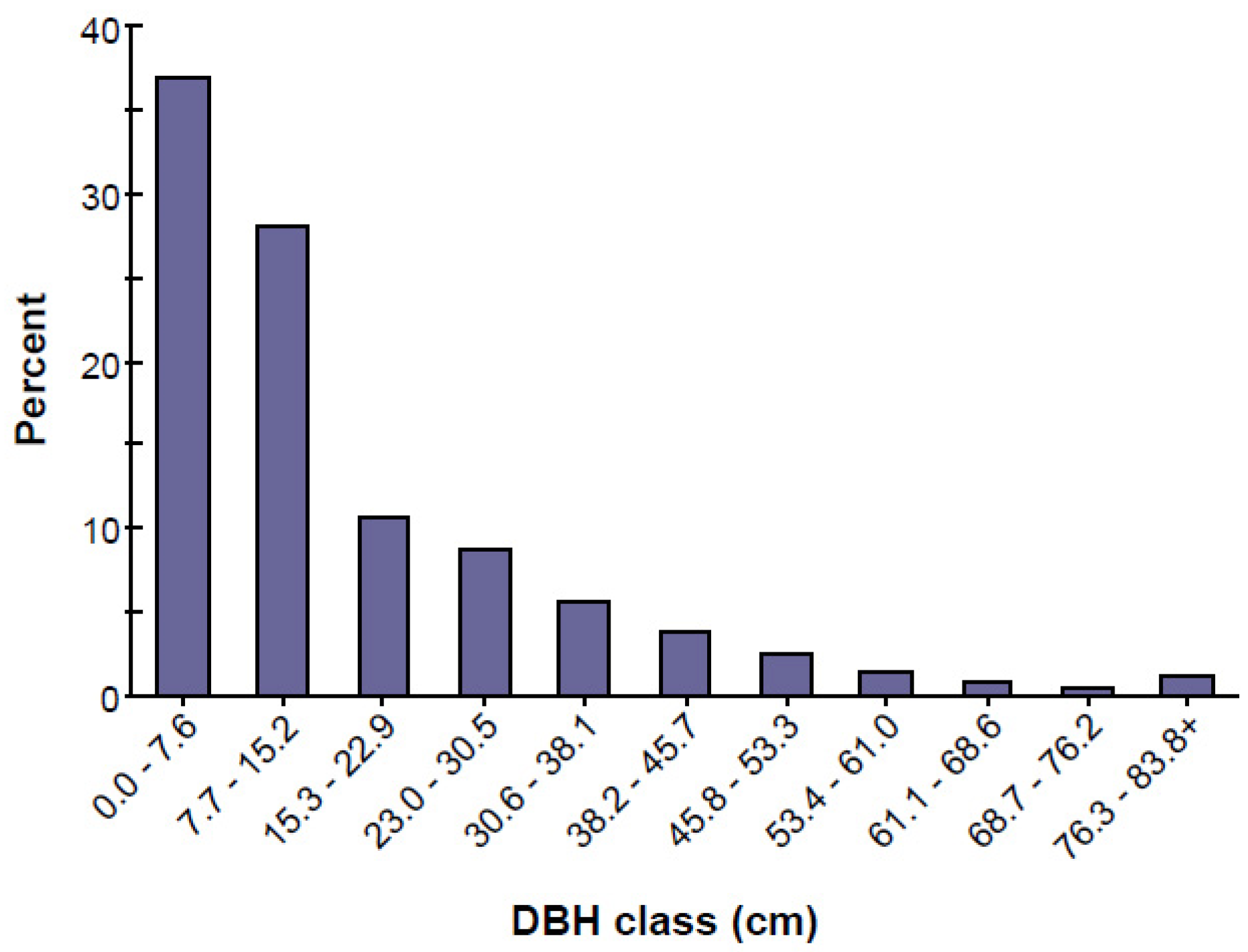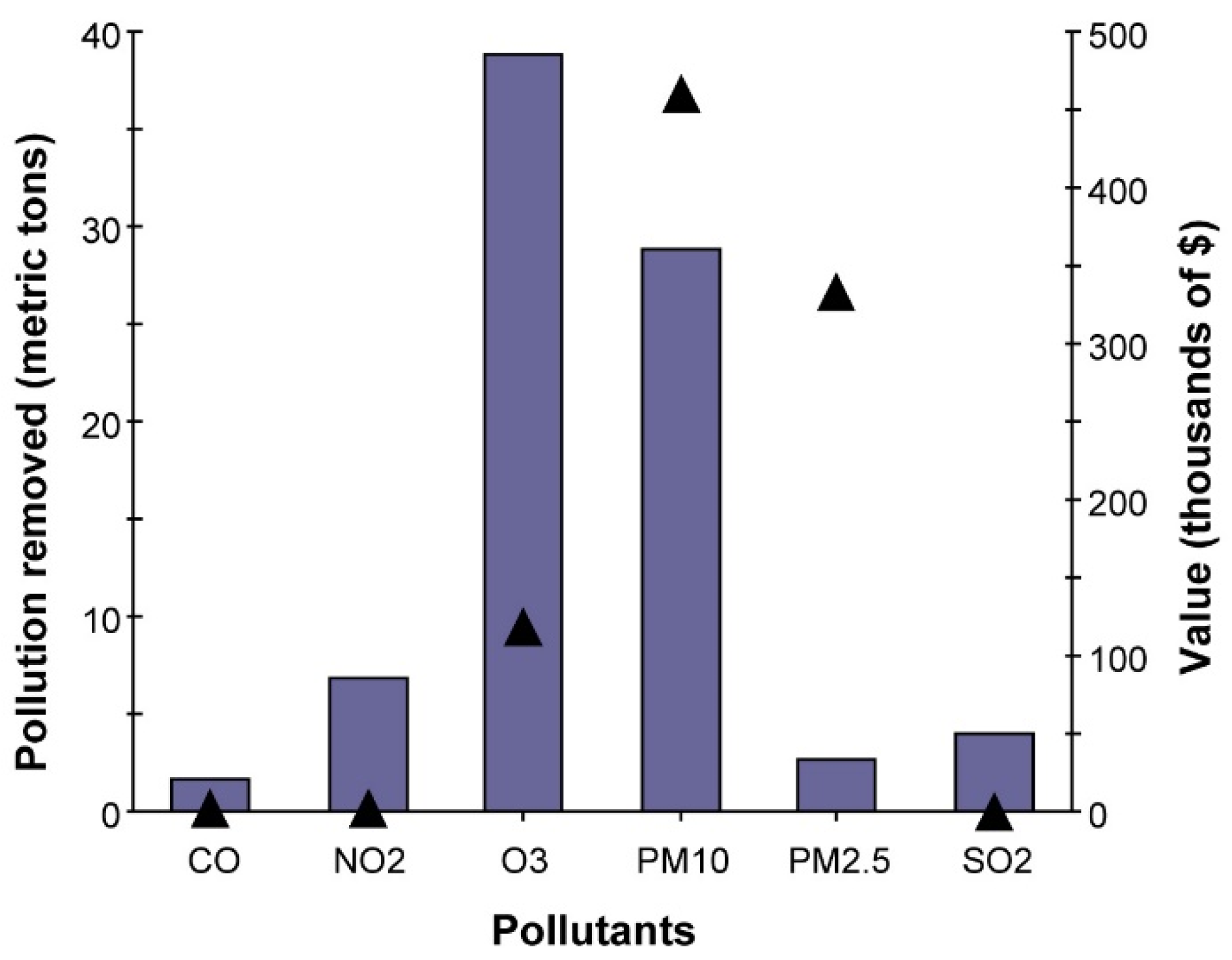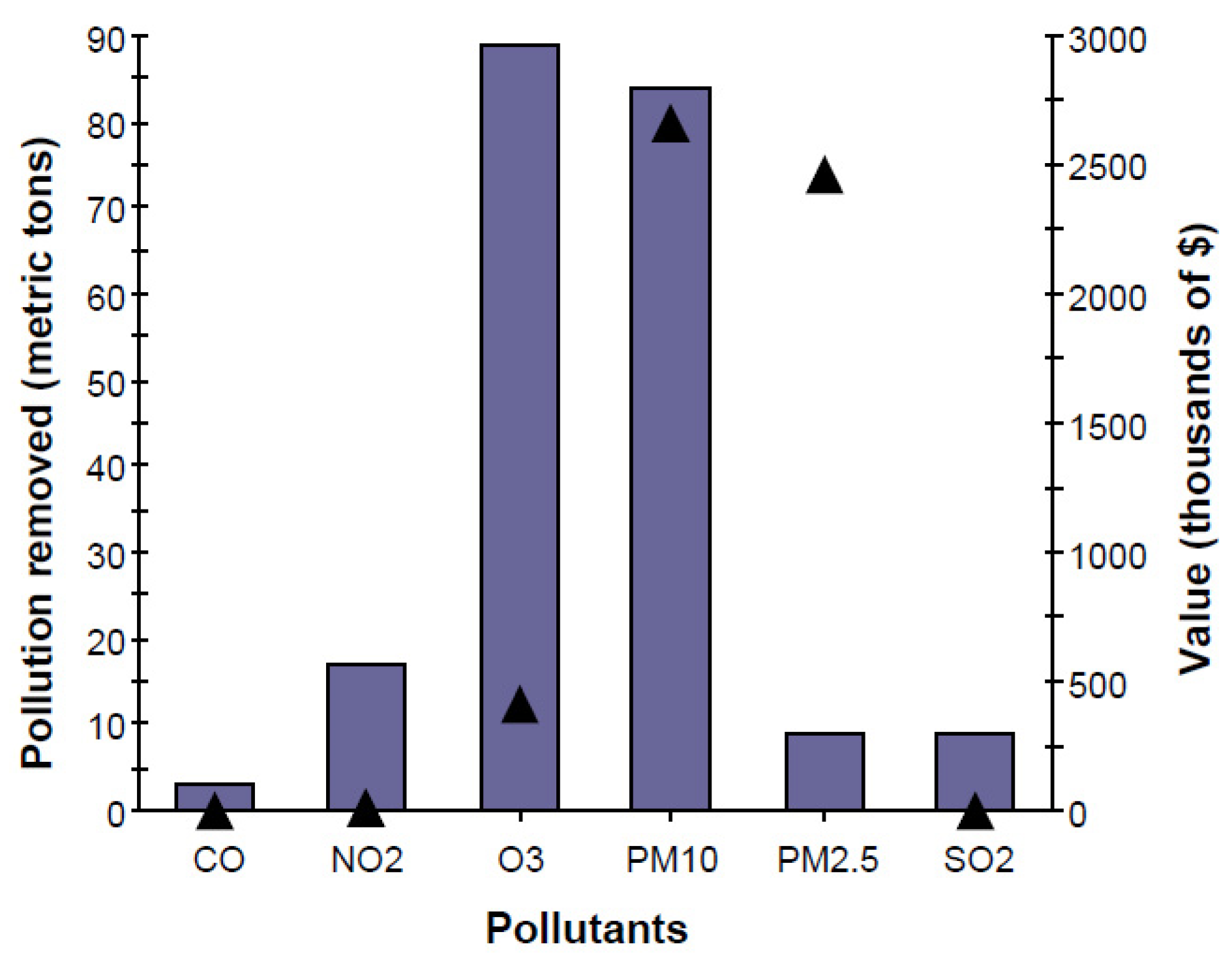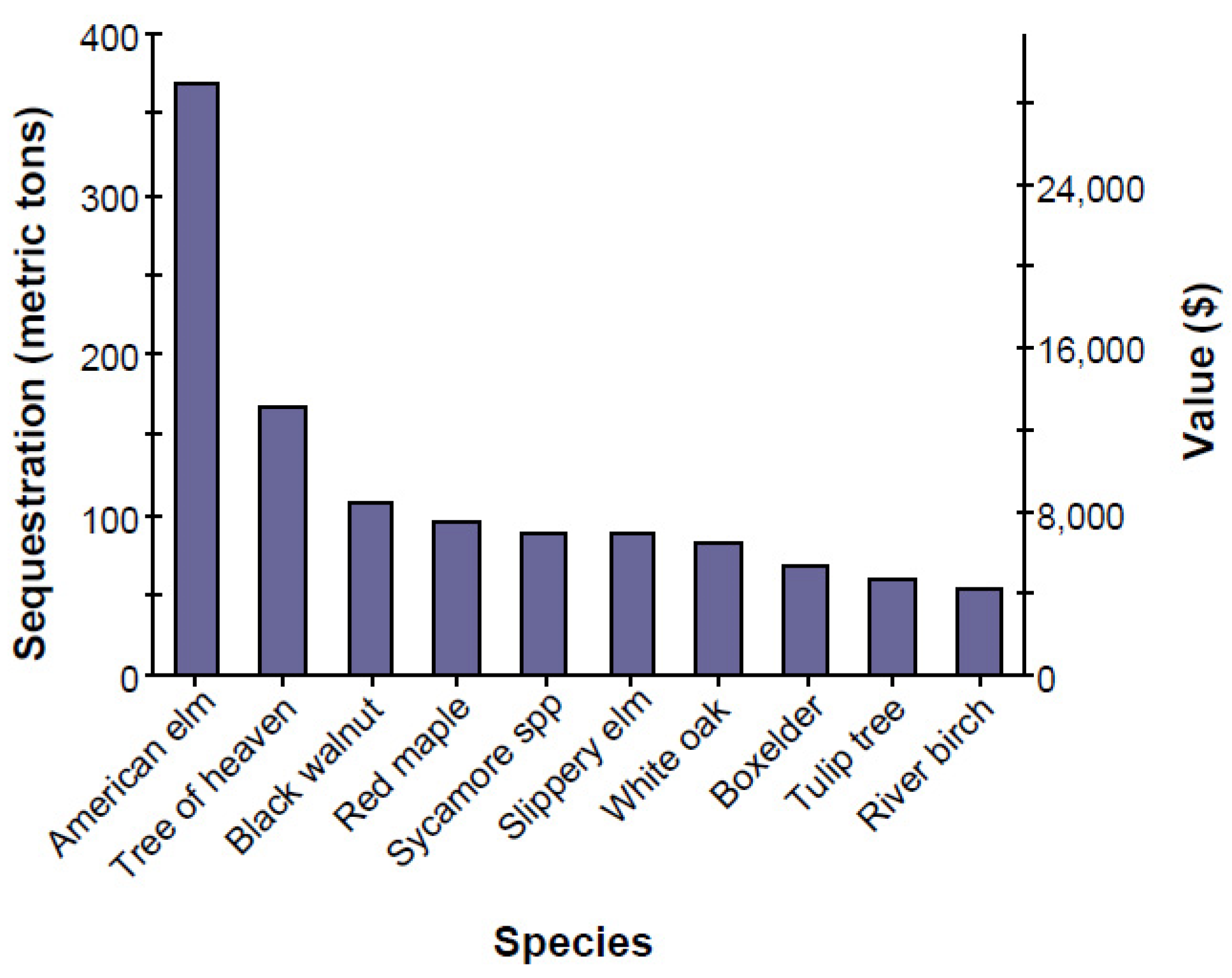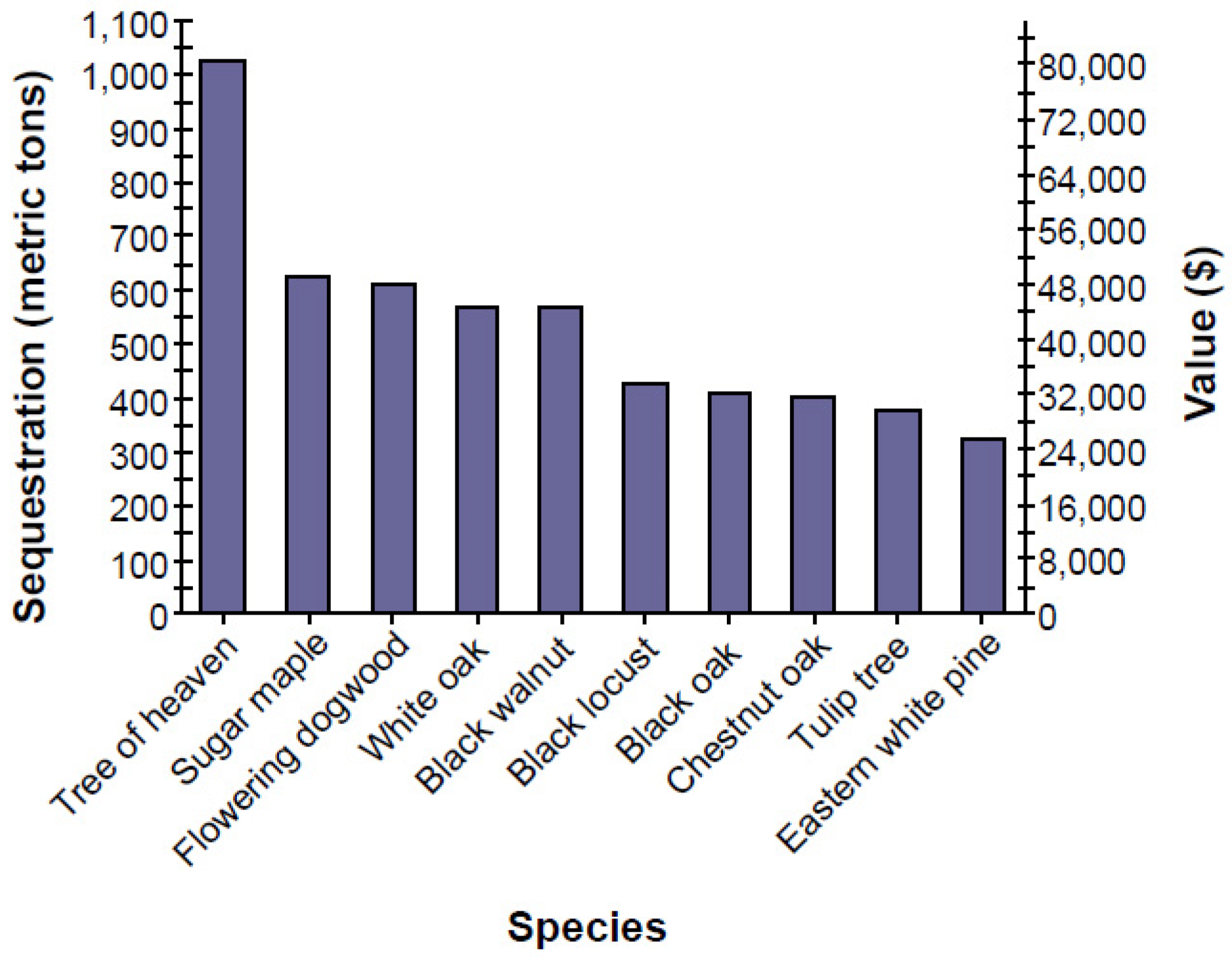1. Introduction
The extent to which forests provide ecosystem services depends upon their forest structure (e.g., tree species composition, number of trees, tree size, leaf area, percentage tree canopy cover, tree condition). These structural attributes help determine the ecosystem services derived from trees in urban areas. Different forest structure results in different ecosystem benefits and value among different land uses. Vacant urban land can cover a significant amount of the urban landscape. According to a 2000 Brookings Institution study, vacant land comprised an average of 15% of the land area in 70 U.S. cities [
1]. This analysis does not differentiate between different types of vacant land, which can consist of anything from undistributed open space to abandoned, contaminated brownfield sites. The amount of vacant land continues to rise with vacant parcels increasing from 6.8 million nationwide in 2000 to 10.3 million by 2010, a 51% increase [
2]. While this problem is especially severe in cities experiencing a population decline, many cities with growing population have also experienced an increase in vacant land. For example, Tucson, AZ, experienced a 6.9% increase in population but a 57.8% increase in abandoned buildings between 2000 and 2010. Indianapolis, IN, and Las Vegas, NV, experienced population increases of 4.9% and 22% but had 48.8% and 137.4% increases in abandoned properties, respectively, over the same period [
2].
There are relatively few studies on the ecology of vacant lands [
3]. For the most part, urban vacant land is not managed for its environmental benefits. Most urban vacant land is viewed only from an economic perspective of highest and best use, being left until it is economically viable to be developed [
4]. However, vacant land provides varying levels of ecosystem services and benefits [
5]. Urban vacant land can provide more environmental services to cities if managed properly. Vacant land provides important ecological habitats for a wide range of plants, birds and insects, supporting biodiversity and urban wildlife health [
6]. In addition, vacant land can provide biological control of insects [
7] and provide for productive food webs [
8]. From an urban ecology perspective, urban vacant land has potential as a valuable ecological resource in the terms of agriculture, forests, and riparian zones [
9].
Re-imagining urban vacant land is critical to developing alternative ways to “reuse wasted land” in urban areas. Vacant land can be a valuable ecological resource, acting as green infrastructure that can be used to enhance ecosystem health and promote a better quality of life for city residents [
5]. According to the U.S. Environmental Protection Agency (EPA), green infrastructure is an “adaptable term used to describe an array of products, technologies, and practices that use natural systems—or engineered systems that mimic natural process—to enhance overall environmental quality and provide utility services” [
10]. Urban vacant land is not normally thought of as green infrastructure, partly because the potential community benefits provided by these spaces are not recognized. One way of addressing this failure is to assess the environmental benefits and ecosystem services provided by vegetation on vacant lands that can potentially play an important role in creating healthy, livable and sustainable cities.
Vacant land use planning could enhance ecosystem services by setting ecosystem productivity standards that would meet or exceed the ecosystem benefits produced by residential land. Single family residential land use is a dominant land use in cities with moderate amounts of impervious surfaces and tree cover that averages around 31.4% in forested regions [
11]. It might be reasonable to manage vacant lands to produce similar or greater eco-system benefits than residential land, particularly in forested regions. To this end, this paper illustrates differences in residential and vacant land, both in terms of forest structure and ecosystem benefits in Roanoke, VA. The ecosystem services in this study included air pollution removal value, carbon sequestration and storage, avoided runoff, energy savings in building energy use, and structural value of trees on vacant and residential land. The goal of this assessment is to better understand how vacant land might be better utilized to provide ecosystem services for Roanoke. Vacant land may offer alternative creative open spaces and landscape design in a city to enhance the city environment.
2. Methods
The i-Tree Eco computer model (
www.itreetools.org) was developed to help managers and researchers quantify urban forest structure and functions based on standard inputs of field, meteorological, and pollution data [
12]. i-Tree Eco analyses can be based on a sample of an area (e.g., an entire city or neighborhood) or an inventory of trees (e.g., street trees). Model outputs are given for the entire population and individual trees measured [
13]. Results from the i-Tree Eco model are used to understand the urban forest structure, ecosystem services and values to help improve urban forest policies, planning, and management [
14]. These data also provide support for the potential inclusion of trees within environmental regulations, and to determine how trees affect the environment and, consequently, enhance human health and environmental quality in urban and rural areas [
14].
This model was used to assess green infrastructure structure, services and value of vacant land and residential land in Roanoke. Within each land use, randomly located 0.04 ha field plots were measured. Plot measurements include the percent of plot tree cover, shrub cover, plantable space, and ground cover types. Trees on each plot were also measured for total height, Diameter at Breast Height (DBH; 1.37 m from base of tree), crown width, percentage of canopy missing and dieback, crown light exposure, and distance and direction of trees to nearby buildings. A total of 197 plots were sampled across the two land use types: vacant land (114) and single family residential land (83). Plots on both public and private property were assessed. All field data were collected during the 2012, 2013 leaf-on season (June–July) to properly assess tree canopies. Field data were input to the i-Tree Eco model to assess forest structure and associated ecosystem services and values [
15].
Air pollution removal estimates are derived from calculated hourly tree-canopy resistance for ozone, and sulfur and nitrogen dioxides based on a hybrid of the big-leaf and multi-layer canopy deposition models [
16,
17]. As the removal of carbon monoxide and particulate matter less than 10 microns by vegetation is not directly related to transpiration, removal rates (deposition velocities) for these pollutants are based on average measured values from the literature [
18,
19] and adjusted depending on leaf phenology and leaf area. Particulate removal incorporates a 50% re-suspension rate of particles back to the atmosphere [
20]. The estimation of the pollution removal value of trees was based on field data and pollution and weather data (2011).
Tree store and sequester carbon dioxide through their growth process in their tissue. Carbon storage and carbon sequestration is estimated based on tree species, size and estimated growth rates. Carbon storage and carbon sequestration dollar values are calculated based on $78.5 per metric ton of carbon [
21]. As trees die and decay, they release much of the carbon that they store.
Trees on urban vacant land affect energy consumption by shading buildings, providing evaporative cooling, and blocking winter winds, thus reducing building energy consumption in the summer months, either increasing or decreasing building energy use in the winter months, depending on the location of trees around the building. Estimates of tree effects on energy use are based on field measurements of tree distance and direction to space conditioned residential buildings [
22]. Energy savings are converted to monetary savings based on state average energy costs.
Structural value of an urban forest is estimated based on valuation procedures of the Council of Tree and Landscape Appraisers [
23], which uses information on three species, diameter, condition, and location [
24]. Plantable space is not covered by impervious surfaces and is free of overhead obstructions such as existing tree canopies and utility lines [
25]. The percentage of the area beneath the dripline of the tree that is impervious is used in runoff calculation.
4. Discussion
A major driver of the type and quantity of ecosystem services in urban areas is land cover [
31]. The land cover of vegetation and bare soil provide more provisioning services (e.g., food production, water supply), regulating services (e.g., climate regulation, air pollution removal), and supporting services (e.g., nutrient cycling, soil building) than non-vegetated and impervious surfaces [
31,
32]. Urban forest cover reduces the impact of impervious surfaces, such as roads, buildings, and to a lesser degree maintained grass. Impervious surfaces reduce water infiltration and increase runoff, affecting residential water quality. Trees and vegetation ground cover types reduce storm water impacts by intercepting rainfall, slowing water movement, and increasing absoprtion in the ground.
Vacant land forest structure can be a very cost-effective way of reducing the need for expensive storm water management infrastructure such as retention tanks and sewer systems [
33]. Vegetation uses storm water as a resource, capturing a significant percentage of run off. The current forest structure on vacant land can help manage urban storm water to prevent residential floods and can also filter the polluted water running off cities’ impervious paving areas, such as parking lots and road systems, to renew clean ground water systems. Vacant land is thus an important component of urban green infrastructure systems that can significantly affect the health of the local urban ecosystem, providing enduring value for the community. Vacant land supports 59.2% of the plantable space, which is higher than residential land (29.2%) (
Table 4). Vacant land is also 24.8% wild grass, which is again higher than residential land (1.8%). This means that vacant land can be strategically used as part of the urban green storm water infrastructure. Most vacant land consists of previously developed land that is now vacant with no structures, although some vacant sites contain a natural forest structure, which means that vacant land can be easily built upon and there are no environmental and physical constraints to redeveloping those spaces so they can be easily managed for redevelopment as green infrastructure, such as small parks, urban agriculture and community gardens, in the future. Vacant land therefore has a high potential value as green infrastructure that can be used to provide ecosystem services for city residents.
Climate change is a major issue around the world. Trees can remove carbon dioxide through photosynthesis in their tissue, which can help counteract climate change. Trees also alter energy consumption by reducing carbon dioxide emission from the fossil-fuels burned by power plants [
34]. Trees on urban vacant land reduce the amount of carbon in the atmosphere by sequestering carbon in new growth every year. The amount of carbon annually sequestered increases with the size and health of the trees. Biomass is a renewable energy source that can either be used directly via combustion to produce heat, or indirectly after conversion to various forms of biofuel. Urban vacant land is a valuable ecological resource that can be an effective biomass energy resource and also reduce carbon dioxide in the atmosphere by capturing carbon in new growth every year in a city.
Surface runoff can be a cause for concern in many urban areas as it often increases pollution in streams, wetlands, rivers, lakes, and oceans. When it rains, some portion of the precipitation is intercepted by vegetation (trees and shrubs) while the remainder reaches the ground. The portion of the precipitation that reaches the ground and does not infiltrate into the soil becomes surface runoff [
35]. In urban areas, the extensive area covered by impervious surfaces increases the amount of surface runoff. The plantable space available on the vacant land is about 59.2%, which is much higher than residential land (29.2%). Vacant land therefore has considerable potential to reduce surface runoff if planting of vacant lands is increased. Vacant land may be a valuable ecological resource that can be strategically used as urban green storm water infrastructure through urban forests, including trees, shrubs and pervious ground cover classes. For example, urban trees in Roanoke are highly beneficial in reducing surface runoff. Trees intercept precipitation, while their root systems promote infiltration and storage in the soil.
The results of the comparison of urban forests effects and values by land use suggest that residential land use offers the greatest current and potential future ecosystem benefits on a per ha basis. However, city totals for Roanoke’s carbon storage and carbon removal value in urban vacant land is high compared to residential land based on number of trees (210,263–1,682,518) (
Table 10). Vacant land can thus be one of the most effective ecological resources providing ecosystem services in a city. Trees on urban vacant land that are growing in natural stand conditions have more large trees with low density and a higher percentage cover (
Table 1) and, thus, more above-ground biomass (carbon storage) than open-grown trees located on residential land [
5].
Many residential trees are intentionally planted, so longer life trees and low maintenance trees are needed to reduce the tree death level, and to reduce pollutant emissions from maintenance activities. Also, a planting plan of residential areas needs to consider the service provided by trees in conserving energy in locations near residences, as well in providing shade for parking lots, reducing pollution from power plants and reducing vehicular VOC pollution. When people select tree species for residential land, pollutant-sensitive species should be avoided, and plantings should include the use of evergreen trees to improve tree-health and remove year-round particulate matter.
The comparison of the effects and values of urban forest on vacant and residential land indicates that vacant land has a high potential value as green infrastructure for providing ecosystem services for the city. Vacant land can be strategically used for urban green storm water infrastructure in urban forests, including trees, shrubs and pervious ground cover classes. They can be easily managed for redevelopment as green infrastructure, such as small parks, urban agriculture and community gardens in the future. Vacant land is a valuable ecological resource that can be an effective biomass energy resource and reduce carbon dioxide in the atmosphere by capturing carbon in new growth that occurs every year in a city. These results suggest that vacant urban land is a vital resource and a useful component of the city’s green infrastructure that provides significant benefits and should therefore be managed so as to increase its effectiveness and minimize any negative effects. The results of the comparison of urban forest effects and values on vacant and residential land suggest that the high ecosystem values of vacant sites should be protected, although these sites could be developed for a variety of uses if done in a manner that protects their current ecosystem values. Less sensitive vacant sites that have low ecosystem values could be developed for many different types of land use (e.g., housing, commercial, industry and green re-use options) as they have the most potential for improvement and increase in ecosystem benefits. Those vacant sites with historical significance that have remediation potential could be developed in a manner that preserves their historical value with a historically appropriate use. If other vacant sites have low ecosystem values and are not threatened by development, their current low ecosystem values have the potential to be enhanced through proper management.
5. Conclusions
The purpose of assessing vacant and residential land forest structure and ecosystem services in this study was to demonstrate how vacant urban land functions as green infrastructure that provides ecosystem services and value to society. Understanding an urban forest’s structure, function and value can promote decision-making that will improve human health and environmental quality. The ecosystem services identified in the vacant land study in this paper captured the current structure of Roanoke’s urban forest growing on vacant land and quantified a subset of the ecosystem functions and economic values it provides to Roanoke’s residents. Trees on vacant urban land in Roanoke store 97,500 t of carbon (29,400 kg per ha) valued at $7.65 million ($22.932 per ha). These trees annual accumulate additional carbon of about 2090 t (630 kg per ha) valued at $164,000/year ($491.4/year per ha), which is high compared to residential land in the city. The trees on Roanoke’s vacant land also remove an estimated 83 t of air pollution annually (0.02 t per ha) valued at $916,000 ($220.72 per ha per year). These trees also reduce energy-related costs from residential buildings by about $211,000 annually, and additionally reduce power plant carbon emissions valued at $28,103 (358 t).
The ecosystem services provided by Roanoke’s urban vacant land were analyzed using the i-Tree Eco model, which facilitates the creation of ecological design guidelines for future development. Although these spaces are now beginning to receive more attention, as yet there are no strategic plans for utilizing them more effectively. The ecosystem services provided by the vacant land in the City of Roanoke, Virginia, described in this study suggest new ways to reinvigorate or revitalize these spaces in terms of their ecological value. An analysis of the structure, function, and economic benefits of urban vacant land can be a useful reference for local authorities, landowners and regeneration professionals, as well as providing a rationale for a change in current approaches towards potentially valuable urban vacant land. The overall aim in the study is to advance knowledge about the value of vacant land within an urban landscape. These places may offer alternative, creative ways to envision urban open space and landscape design in a city. Urban vacant land will be redefined as a valuable resource when considered from a different perspective as a potential redevelopment. This can have important implications for policy development allowing practitioners to better understand urban vacant spaces, and can lead to better utilization of these spaces.
